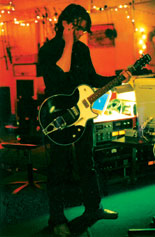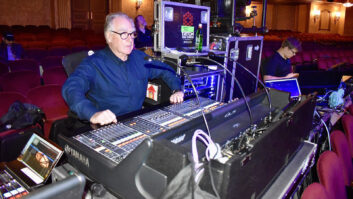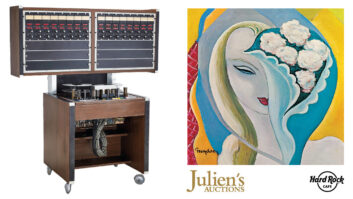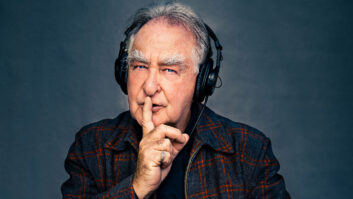
Eric Ambel is sitting on a comfy couch inside the basement digs of Cowboy Technical Services, an analog/digital recording studio in the Williamsburg section of Brooklyn. Chiefly known for its Italian ravioli factories and Peter Luger’s steakhouse, Williamsburg is a short subway ride from downtown Manhattan. Ambel is juggling mixing sessions in his studio, live gigs in his club, CD releases for his record label, tracks from a band he is producing, his own songwriting demos and his e-mail — all from his laptop.
Bespectacled and wearing biking shoes, shorts and his Mac iBook, he doesn’t look much like a hard-rocking, guitar-slinging cowboy from Wyoming. But one listen to his music — his guitar is a muscle car rumble, then it’s a gut-wrenching squeal, then it’s an infectious rootsy riff — and you hear the man they call “Roscoe.” Ambel first claimed major fame as The Blackhearts’ guitarist on Joan Jett’s hits “I Love Rock & Roll” and “Crimson and Clover.” In the late ’80s, his guitar powered New York roots rockers the Del Lords. Through much of the ’90s, Ambel developed a reputation for his powerful guitar sound and for producing (and usually playing on) album projects by Nils Lofgren (Crooked Line, which featured the vocals, harmonica and guitar of Neil Young), Mojo Nixon (Whereabouts Unknown), The Bottlerockets (Brooklyn Side and 24 Hours a Day) and Mary Lee’s Corvette (several albums). This past year, he released his own tough, raw album of blazing rock tunes, called Knucklehead, comprising tracks recorded in many different recording situations with a wide variety of musical friends and colleagues. More recently, he’s been producing and playing with The Yayhoos, which features Ambel and former Georgia Satellites frontman Dan Baird (a frequent musical partner through the years) for an upcoming Bloodshot Records release.
Ambel is a testament to the complementary nature of wearing many hats in the music game: guitarist, singer/songwriter, producer, club owner, record label CEO, studio owner, bandleader for his band, Roscoe’s Gang, and lead guitarist for Steve Earle’s band, The Dukes. A determined D.I.Y. type, Ambel didn’t let recording industry roadblocks get in the way of his music. When he grew tired of sharing the stage at clubs vying for the attention of A&R executives, he built his own club (Lakeside Lounge in Manhattan’s East Village) that is committed to having one band per night. When fans couldn’t get his out-of-print records, he started his own label (Lakeside Lounge Records) and distributed the CDs from his Website, www.ericambel.com.
Ambel set up Cowboy Technical Services with partners Tim Hatfield, Dan Pifer and the band Martin’s Folly in January of 2000. From spending many hours in professional studios in L.A., Nashville and New York City, he learned what was essential to a good recording studio: “It’s not the pretty receptionist or the catering,” he says, “it’s the gear and the vibe. A lot of times, we would pick a studio for its equipment list. When we got there, the box we wanted to use would have a DNU [do not use] sticker on it. We’ve opted to spend money on solid gear.”

Tim Hatfield at the Neotek Elan
Ambel met up with engineer/partner Hatfield while they were doing a Del Lords session at New York’s Media Sound, around 1986. Hatfield and Ambel formed a fast friendship based on fine music and hot barbecue. Hatfield has quite the impressive resumé, including work with famed producers Arif Mardin, Tom Dowd and Jack Douglas. Hatfield engineered many of Ambel’s producing gigs during the ’90s. When Ambel decided to open a recording studio, Hatfield was an obvious choice to be his chief engineer and partner.
Ambel and Hatfield wanted a recording environment without a control room, in which the engineer is right in the room with the musicians. “We wanted to have a place where an artist would feel at home and relaxed,” Hatfield, a native Texan, says, “so the creativity would flow. Not having a control room makes the communication easier and that enhances the performance of the musicians because everyone feels totally connected.”
One end of the studio is devoted to the band and the other end is devoted to recording gear. (Iso booths are also available.) “When you think about it,” Ambel offers, “you probably only spend about 15 percent of your time cutting drums. So why spend a lot of money building a little box for you to sit in all the time?”
The idea to start his own recording studio came when he was producing bands in other people’s studios. “I was doing a lot of work producing other bands around Brooklyn, at Coyote Recording, which is owned by Mike and Al Caiati, the brothers of Del Lords bassist Manny Caiati,” he recalls. “I did a lot of projects there, way back before Williamsburg had any sushi joints.” In fact, Brooklyn has become home to many musicians and recording studios squeezed out of Manhattan’s rent realities. Ambel has done much for the emerging Brooklyn music scene. Later, he worked at Brooklyn’s 33⅓ studios: “33⅓ was a fantastic fluke room — a room that happened to sound good accidentally,” he recalls. “It was very cool-looking, too. We got seduced by it and ended up paying to work there. We let the owner use our gear until we wised up and bought our own console and moved out.”

Cowboy Technical Services’ control room
The hand-built Neotek Elan 32-input, 24-bus console that formerly resided at Word Music in Nashville is now the centerpiece of Cowboy Technical Services’ recording rig. “Since most everything we mix these days comes from DP [Digital Performer], Pro Tools or a combination of digital and analog,” Hatfield explains, “we need the Elan to spread out the outputs and use our outboard gear. The Neotek helps us keep dimension in the sound.”
There is a nice assortment of mic preamps and compressors racked at CTS, including Neve 1067, Telefunken V-72 and Avalon 737 units. Ambel especially fancies Crane Song mic preamps: “We’ve been getting really nice vocals using the Beyer M-500 hypercardioid ribbon mic through the Crane Song Flamingo [dual Class-A mic preamp] and a [UREI] 1176.”
Because of his reputation as a roots rocker, I assumed Ambel would track everything on analog. Not true. Well, partially true: “I prefer to track analog at 15 ips to 2-inch for more bottom,” he says. “But I always work in a hybrid fashion of capturing the track on analog and bumping it over to digital as soon we get a take.”
Ambel is also a big advocate of MOTU Digital Performer. (CTS also has Pro Tools.) A Macintosh G4 dual-867 computer, working with Digital Performer Version 4.12 and the MOTU 424 24 I/O Core System, handles hard disk recording. “Then, with the portable MOTU FireWire hard drive,” Ambel says, “I can take the track home and work on tweaking the song on my laptop. In fact, Matt Svbodny and I recorded the Steve Earle live album Just an American Boy on my 600-megabyte laptop with the MOTU portable FireWire rig.”
Musicians, and especially guitarists, love the assortment of musical instruments at CTS: more than 30 rare and vintage guitars, a Hammond A-100 organ with Leslie 147 rotating speaker, a sweet Premier drum kit with a Ludwig marching kick drum and Pearl piccolo snare. You’ll find the requisite selection of Fender tube amps, but you’ll also find amps custom-tweaked for Ambel: “Blackie Pagano from Tubesville Thermonics here in New York does a fantastic job keeping my amps in top shape,” Ambel says. “Blackie built me a special power amp out circuit for that fat output tube distortion I like.”

Ambel reveals one of his tracking techniques for capturing a meaty, muscular guitar sound: “These days, I rely on more low-wattage amps, like the Fender Pro Junior and the Dr. Z MAZ 18 Jr. and the Dr. Z Z-28. They are very responsive Class-A guitar amps. I like to use the Royer 121 or my RCA Velocity Junior ribbon mics about 18 inches from speakers in closed-backed cabinets. If they sound too roomy, I’ll put a gobo behind the microphone to deaden the back portion of the figure-8 pattern. I’m usually using a Telefunken V-72 for a preamp and a Manley ELOP compressor [then going to tape].”
Ambel credits much of his engineering skill to working with Del Lords engineer/producer Lou Whitney. In fact, Ambel frequently recorded and mixed his demos first on a Fostex X15 4-track and then on a Tascam 688 cassette 8-track. “The first record I made was in ’77, out in Wyoming,” he recalls. “So by the time I was in Joan Jett’s band, I had already made quite a few records, including ones where we did every step of the process ourselves, which was a good education. By the time I was in the Del Lords, I was recording and mixing my own demos at home on my 4-track.”
These days, Ambel leaves the tracking to Hatfield while he jams with the band, often adding guitar or backing vocals to the acts he produces and records at CTS. Similarly, the “no control room” design promotes the idea that the engineering process be as transparent as possible. Without the specter of “the man behind the glass,” the band (including the producer) is more comfortable and more apt to create better music.
“It’s all about the music, and that applies to our studio, as well,” Ambel concludes. “I know we have done a great job when the guitarist or drummer listens to a playback and says that track sounds the way I played it.”







